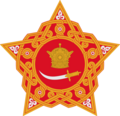Difference between revisions of "Tamir Khanate"
m |
|||
| Line 67: | Line 67: | ||
|leader2 = Tamaghli Qamaşan <small>(last)</small> | |leader2 = Tamaghli Qamaşan <small>(last)</small> | ||
|year_leader2 = 1202-1220 | |year_leader2 = 1202-1220 | ||
|legislature = [[Qazsara]] | |legislature = [[Qazsara]] | ||
|stat_year1 = | |stat_year1 = | ||
| Line 73: | Line 72: | ||
|currency | |currency | ||
|today={{plainlist| | |today={{plainlist| | ||
*{{flag|Komania}}}} | *{{flag|Vogia}} | ||
*{{flag|Fukota}} | |||
*{{flag|Rusovan}} | |||
*{{flag|Komania}} | |||
*{{flag|Khezan}} | |||
*{{flag|Araman}} | |||
*{{flag|Torosha}}}} | |||
|footnotes = {{notelist}} | |footnotes = {{notelist}} | ||
}} | }} | ||
Revision as of 18:08, 14 May 2023
| Tamir Khanate | |||||
| . Qaz Tamiryan . Qaz Tamiryan (Koman) | |||||
| |||||
The Tamir Khanate c.1050
| |||||
| Capital | Sherwan | ||||
| Languages |
| ||||
| Religion | |||||
| Government | Hereditary monarchy | ||||
| Qāk | |||||
| • | 700s-724 | Qazşam Qashir (first) | |||
| • | 1202-1220 | Tamaghli Qamaşan (last) | |||
| Legislature | Qazsara | ||||
| Historical era | Middle Ages | ||||
| • | Established | 700 | |||
| • | Disestablished | 1220 | |||
| Today part of | |||||
| Warning: Value not specified for "continent" | |||||
| This article is part of a series on |
| History of Komania |
|---|
 |
| Ancient Period |
|
|
| Imperial Period |
| Warring Period |
| Modern Period |
The Tamir Khanate was a medieval Vaniuan state formed by a collection of aligned tribes and ruled under several dynasties by the Kalkali people in the area between the Miralayas and west Vaniua over the Golden Steppes. From the beginning of the 8th century to the 13th century, it existed as a tribal confederation and later as a Khanate until its fall around 1220.
Name
The name "Tamir" is believed to have its roots in the word for iron, *dɒmæɣ, in the Kalkali language. This term was possibly initially employed to denote the foundational tribes of the Qom Confederation, preceding the establishment of the khanate itself. However, as the influence of the Tamirs extended, the term gradually became a reference for the reigning dynasty. Furthermore, it was also used to refer to the tribes comprising the khanate. The name itself did not refer to any ethnic group and was used collectively among Qom tribes, northern Vaniuan tribes, and other minorities.
As the Sunrise Horde expanded, leading to the decline and ultimate fall of the Tamir Khanate, the tribes that endured and migrated to the Tarkhan Mountains became collectively known as 'Kalkali' (derived from the Galkhai dynasty). This term was adopted to differentiate these later arrivals from the Tamirs who had already established their presence in the region prior to the khanate's collapse.
Contemporary scholars and archaeologists frequently employ the term 'Kalkali' as a blanket descriptor for the Tamir Khanate, its populace, and their languages, a usage which is somewhat misleading. In reality, the Tamirs did not adopt a singular, overarching term to identify themselves. Instead, their self-identification was rooted in tribal affiliations, underscoring a more nuanced social structure than the simplified 'Kalkali' label might suggest.
The later Asharids co-opted the term 'Kalkali' for their self-identification, a move to assert their direct lineage and heritage from the renowned Sunrise Horde. This appropriation served to legitimize their position and connect them to the illustrious past, but also to secure any former claim that might have been established during the Tamir Khanate.
Origin
The Kalkali Khanate originated as a tribal union of 6 tribes. These originated from the eastern steppes of northern Vaniua, which according to the book of "Ēmēşh-e Bēşom" Winds of the North (c.1344) migrated westwards after the fragmentation of the Qom confederation. Driven by the Golden Steppes these tribes came to establish the city of Sherwan which at the time served as a trade outpost. Under the rule of the warlord Qashir the khanate came to conquer three-thirds of northern Vaniua, a task that remained a priority by its following rulers.
